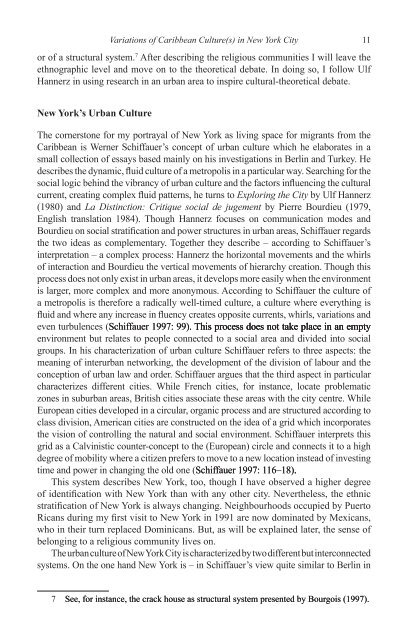You also want an ePaper? Increase the reach of your titles
YUMPU automatically turns print PDFs into web optimized ePapers that Google loves.
Variations <strong>of</strong> <strong>Caribbean</strong> Culture(s) <strong>in</strong> <strong>New</strong> <strong>York</strong> <strong>City</strong> 11<br />
or <strong>of</strong> a structural system. 7 After describ<strong>in</strong>g <strong>the</strong> religious communities I will leave <strong>the</strong><br />
ethnographic level and move on to <strong>the</strong> <strong>the</strong>oretical debate. In do<strong>in</strong>g so, I follow Ulf<br />
Hannerz <strong>in</strong> us<strong>in</strong>g research <strong>in</strong> an urban area to <strong>in</strong>spire cultural-<strong>the</strong>oretical debate.<br />
<strong>New</strong> <strong>York</strong>’s Urban Culture<br />
The cornerstone for my portrayal <strong>of</strong> <strong>New</strong> <strong>York</strong> as liv<strong>in</strong>g space for migrants from <strong>the</strong><br />
<strong>Caribbean</strong> is Werner Schiffauer’s concept <strong>of</strong> urban culture which he elaborates <strong>in</strong> a<br />
small collection <strong>of</strong> essays based ma<strong>in</strong>ly on his <strong>in</strong>vestigations <strong>in</strong> Berl<strong>in</strong> and Turkey. He<br />
describes <strong>the</strong> dynamic, fluid culture <strong>of</strong> a metropolis <strong>in</strong> a particular way. Search<strong>in</strong>g for <strong>the</strong><br />
social logic beh<strong>in</strong>d <strong>the</strong> vibrancy <strong>of</strong> urban culture and <strong>the</strong> factors <strong>in</strong>fluenc<strong>in</strong>g <strong>the</strong> cultural<br />
current, creat<strong>in</strong>g complex fluid patterns, he turns to Explor<strong>in</strong>g <strong>the</strong> <strong>City</strong> by Ulf Hannerz<br />
(1980) and La Dist<strong>in</strong>ction: Critique social de jugement by Pierre Bourdieu (1979,<br />
English translation 1984). Though Hannerz focuses on communication modes and<br />
Bourdieu on social stratification and power structures <strong>in</strong> urban areas, Schiffauer regards<br />
<strong>the</strong> two ideas as complementary. Toge<strong>the</strong>r <strong>the</strong>y describe – accord<strong>in</strong>g to Schiffauer’s<br />
<strong>in</strong>terpretation – a complex process: Hannerz <strong>the</strong> horizontal movements and <strong>the</strong> whirls<br />
<strong>of</strong> <strong>in</strong>teraction and Bourdieu <strong>the</strong> vertical movements <strong>of</strong> hierarchy creation. Though this<br />
process does not only exist <strong>in</strong> urban areas, it develops more easily when <strong>the</strong> environment<br />
is larger, more complex and more anonymous. Accord<strong>in</strong>g to Schiffauer <strong>the</strong> culture <strong>of</strong><br />
a metropolis is <strong>the</strong>refore a radically well-timed culture, a culture where everyth<strong>in</strong>g is<br />
fluid and where any <strong>in</strong>crease <strong>in</strong> fluency creates opposite currents, whirls, variations and<br />
even turbulences (Schiffauer 1997: 99). This process does not take place <strong>in</strong> an empty<br />
environment but relates to people connected to a social area and divided <strong>in</strong>to social<br />
groups. In his characterization <strong>of</strong> urban culture Schiffauer refers to three aspects: <strong>the</strong><br />
mean<strong>in</strong>g <strong>of</strong> <strong>in</strong>terurban network<strong>in</strong>g, <strong>the</strong> development <strong>of</strong> <strong>the</strong> division <strong>of</strong> labour and <strong>the</strong><br />
conception <strong>of</strong> urban law and order. Schiffauer argues that <strong>the</strong> third aspect <strong>in</strong> particular<br />
characterizes different cities. While French cities, for <strong>in</strong>stance, locate problematic<br />
zones <strong>in</strong> suburban areas, British cities associate <strong>the</strong>se areas with <strong>the</strong> city centre. While<br />
European cities developed <strong>in</strong> a circular, organic process and are structured accord<strong>in</strong>g to<br />
class division, American cities are constructed on <strong>the</strong> idea <strong>of</strong> a grid which <strong>in</strong>corporates<br />
<strong>the</strong> vision <strong>of</strong> controll<strong>in</strong>g <strong>the</strong> natural and social environment. Schiffauer <strong>in</strong>terprets this<br />
grid as a Calv<strong>in</strong>istic counter-concept to <strong>the</strong> (European) circle and connects it to a high<br />
degree <strong>of</strong> mobility where a citizen prefers to move to a new location <strong>in</strong>stead <strong>of</strong> <strong>in</strong>vest<strong>in</strong>g<br />
time and power <strong>in</strong> chang<strong>in</strong>g <strong>the</strong> old one (Schiffauer 1997: 116–18).<br />
This system describes <strong>New</strong> <strong>York</strong>, too, though I have observed a higher degree<br />
<strong>of</strong> identification with <strong>New</strong> <strong>York</strong> than with any o<strong>the</strong>r city. Never<strong>the</strong>less, <strong>the</strong> ethnic<br />
stratification <strong>of</strong> <strong>New</strong> <strong>York</strong> is always chang<strong>in</strong>g. Neighbourhoods occupied by Puerto<br />
Ricans dur<strong>in</strong>g my first visit to <strong>New</strong> <strong>York</strong> <strong>in</strong> 1991 are now dom<strong>in</strong>ated by Mexicans,<br />
who <strong>in</strong> <strong>the</strong>ir turn replaced Dom<strong>in</strong>icans. But, as will be expla<strong>in</strong>ed later, <strong>the</strong> sense <strong>of</strong><br />
belong<strong>in</strong>g to a religious community lives on.<br />
The urban culture <strong>of</strong> <strong>New</strong> <strong>York</strong> <strong>City</strong> is characterized by two different but <strong>in</strong>terconnected<br />
systems. On <strong>the</strong> one hand <strong>New</strong> <strong>York</strong> is – <strong>in</strong> Schiffauer’s view quite similar to Berl<strong>in</strong> <strong>in</strong><br />
7 See, for <strong>in</strong>stance, <strong>the</strong> crack house as structural system presented by Bourgois (1997).


















